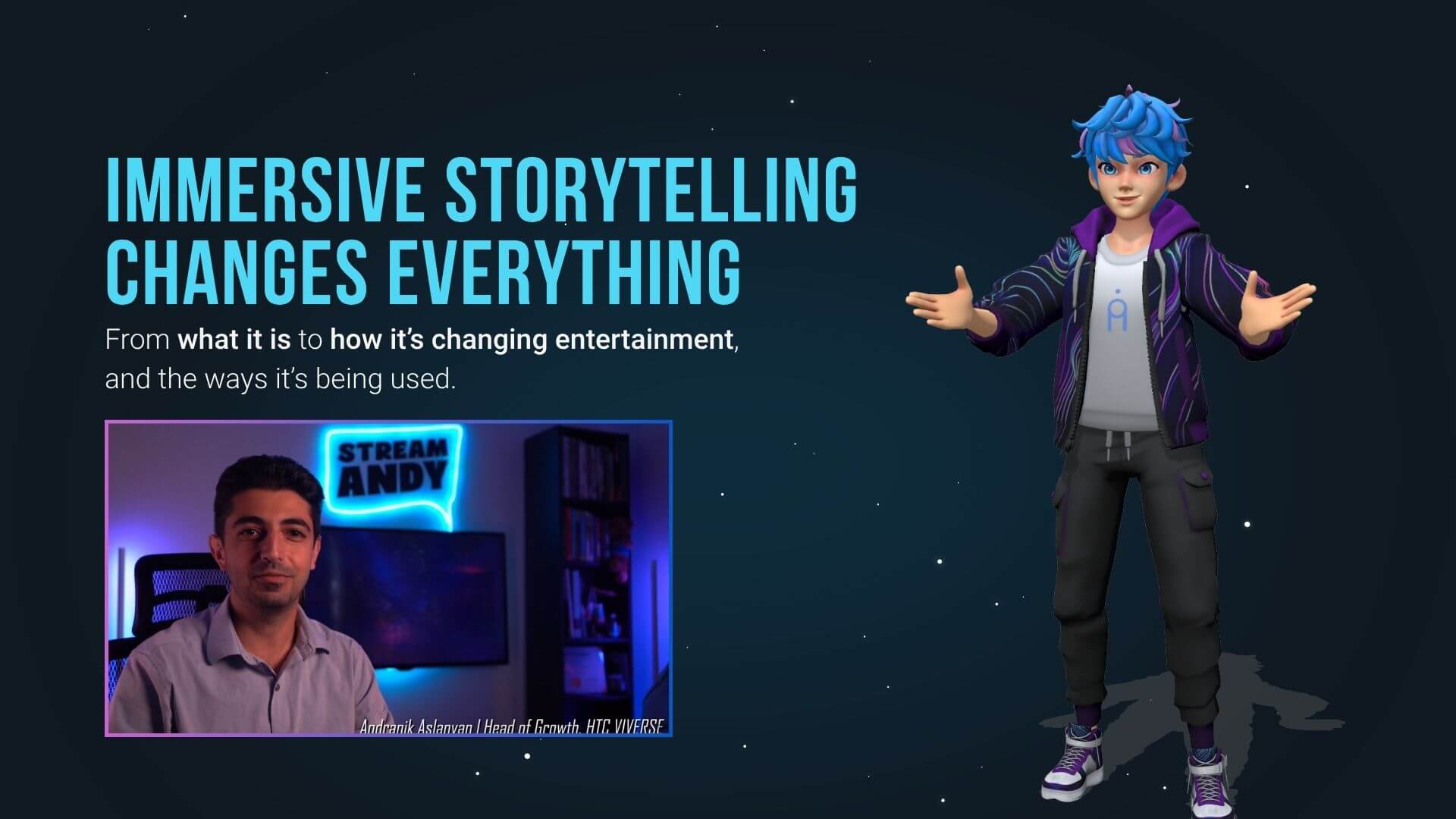What is immersive storytelling? Debunking and explaining the latest trends in AR/VR
By Andranik Aslanyan, Head of Growth, HTC VIVERSE
Immersive storytelling, which combines technology with narratives to create engaging experiences, is reshaping the entertainment landscape. It’s an approach that allows audiences to become active participants in the story as it unfolds.
Offering new ways to captivate audiences, immersive experiences are at the forefront of transforming digital storytelling. They play a key role in enhancing emotional connections and making stories more memorable.
Through this lens of evolution, we see that content creation is similarly undergoing a revolution. New platforms and formats are emerging, driven by the need for more—and better—narratives that offer richer depth in their storytelling to further immerse audiences. This shift is opening exciting opportunities for creators, including platform growth, monetization, and innovative new formats, to create and foster immersive engagement opportunities.
The future of entertainment is bright, and immersive storytelling is leading the charge, promising to deliver unique experiences and transform how we consume stories.
What Is Immersive Storytelling?
Immersive storytelling integrates cutting-edge technology with traditional narrative forms. It often utilizes tools like virtual reality (VR) and augmented reality (AR). These tools transform stories into interactive experiences for users.
VR and AR allow the audience to become active participants. Instead of passively watching, they can explore, influence, and shape what unfolds—creating stronger, longer-lasting emotional connections.
Key elements of immersive storytelling include:
- Interactivity: Audiences live the experiences through a headset or browser.
- Sensory Engagement: Visuals, sounds, and haptics enhance emotional impact.
- Immersion: Being fully encapsulated in the world deepens empathy and understanding.
At its core, immersive storytelling is about transcending boundaries. It invites audiences to explore worlds in a more meaningful way.
Technologies like VIVERSE empower creators and organizations to move beyond flat, 2D media, immersing audiences directly within the story itself. From world-building and multi-format storytelling to community-driven experiences, immersive storytelling proves that anything is possible.
The Evolution of Digital Storytelling
Digital storytelling uses multimedia—images, sounds, and video—to enrich written narratives.
With the rise of immersive technologies, stories have become more dynamic, participatory, and emotionally resonant. Advanced tools enable interactive content, allowing audiences to engage directly with stories and worlds they love.
Digital storytelling continues to evolve alongside new creative tools. It differs from immersive storytelling in that it focuses on:
- Introduction of Multimedia: Combining text, sound, and visuals.
- Interactive Content: Allowing user choices that influence outcomes.
- Immersive Experiences: Using VR and AR for deeper engagement.
This evolution gives creators with new ways to captivate their audiences. As devices become more accessible, digital storytelling’s reach grows exponentially.
Key Storytelling Techniques in Immersive Experiences
In immersive experiences, the narrative becomes a living, breathing entity. It adapts and shifts in response to audience interaction, a dynamic approach that fosters deep connection.
Engaging multiple senses builds a rich tapestry of visuals, sounds, and story, fully drawing audiences into the experience. This transformation turns passive viewers into active participants.
Interactivity is crucial for developing immersive storytelling. Examples include choose-your-own-adventure-style games, interactive films like Bandersnatch from Netflix, and narrative-driven titles from Telltale Games such as Tales from the Borderlands. These experiences invite players to explore different outcomes, heightening emotional impact and memorability.
Crafting realistic environments is another powerful technique. Detailed, responsive settings enhance presence and strengthen the emotional link between audience and story.
How Immersive Storytelling Is Transforming Content Creation
Immersive storytelling expands what’s possible for creators and audiences alike. It introduces new dimensions to how stories are crafted and consumed, sparking fresh opportunities across industries.
A key transformation is the rise of multi-sensory storytelling. Content now goes beyond text and visuals to include sound and touch, making experiences more vivid and personal.
What’s Changing?
- Innovative Platforms: New tools supporting immersive storytelling across multiple media formats.
- Collaborative Processes: Creators and technologists co-develop richer, more layered content.
- Experimentation: Artists and writers are exploring unconventional formats and structures.
These developments lead to content that feels interactive and deeply personal. Audiences increasingly expect a voice in their experiences, encouraging creators to innovate continuously.
As technology evolves, immersive storytelling will continue to redefine how stories are shared and remembered, offering richer, more engaging experiences worldwide.
The Future of Entertainment: Opportunities and Challenges
Immersive storytelling opens vast opportunities for creators and industries alike. As technology progresses, new forms of storytelling emerge. Those who embrace these tools early will lead the way.
However, challenges remain. Accessibility and affordability are crucial for widespread adoption, and high production costs can limit smaller creators.
Future-Facing Creators Should Focus On:
- Technology Integration: Bridging story and technology seamlessly.
- Audience Engagement: Designing meaningful, participatory experiences.
- Sustainability: Managing costs and resources efficiently.
Meeting these challenges requires creativity and strategic planning. By balancing innovation with accessibility, the entertainment industry can advance. Embracing immersive storytelling and platforms like VIVERSE will be key to shaping that future.
Embracing the Immersive Future
The future of entertainment is bright with immersive storytelling at its core. It’s reshaping how stories are told, consumed, and experienced worldwide. From The Wizard of Oz as an interactive movie at the Sphere to virtual test drives accessible from your phone, we’re witnessing how immersive content is redefining everyday experiences.
Want to dive even deeper into Andranik’s insight? His newest Forbes piece explores how immersive storytelling is driving innovation across media and technology, and what it means for the future of entertainment. Read “How Immersive Storytelling Is Powering The Future Of Entertainment“.
Both stories share the same heartbeat—how technology and creativity work together to shape more immersive, human-centered experiences.
Immersive storytelling continues to bridge worlds, spark imagination, and inspire new forms of connection. Explore VIVERSE Worlds, see how creators are shaping the next era of storytelling, and start imagining what your own world could become.
